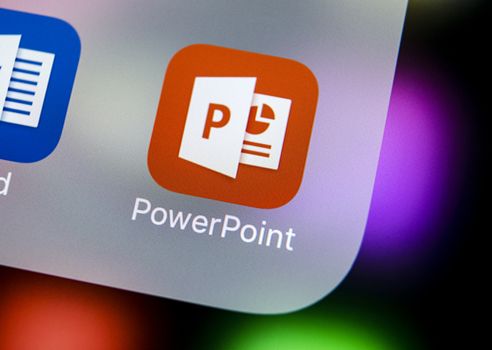Reading time: less than 3 minutes
Many people use PowerPoint as the default tool for writing their speeches and presentations. That’s not always a wise decision….
Whenever I’ve written about the software PowerPoint, I’ve usually received a flood of email. A few readers may disagree with my basic premise that the software sucks. But more of you throw up your hands and say, “OK, Daphne. But let’s get practical here. What can we use to replace it?”
Good point. Here are five suggestions to keep in mind the next time you’re tempted by the siren song of PowerPoint:
1) Don’t write in PowerPoint; instead, mindmap. Let’s talk worst-case scenario and imagine your boss has said she’ll fire you if you don’t use PowerPoint. Well, okay, you’re stuck with the beast. But don’t use it as your planning tool. As I explain in detail in my book, your brain is made up of many different parts. One part (the linear/logical part) excels at making outlines but isn’t very inventive. Another part (the creative part) is a star at coming up with new ideas and connections. But here’s the thing: Only one part of your brain can have control at any given time. And when you write — whether it’s an article, an essay, an advertisement or a presentation — you want the creative part of your brain to be in charge. PowerPoint — the essence of linear, logical thinking — will not let this happen. The solution? Switch to mindmapping. (If you signed up for my newsletter, you should have received my free e-book on mindmapping. If you missed it, go here to sign up now.)
2) Forget about text and instead, use photos, illustrations and videos. Your visual display should support your speech, not supplant it. After all, what’s the value of talking while others are reading? I’ve mentioned Erin McKean before, but in case you missed her marvelous 18-minute presentation to the TED group, have a look now to see how visual images can enhance a speech. Be aware that you can get good quality photos, inexpensively, from sites such as Bigstock Photo and unsplash. And keep in mind that custom illustration is not as expensive as you might think. Talented illustrators work in the newspaper and book industries and are often available for hire at reasonable rates. Contact your local paper or graphic arts school for some names.
3) Have a point. Too many presenters simply do a data dump on their unlucky audience. Always remember that your presentation should be driving to a clear and inexorable conclusion. Presenters like PowerPoint because it makes them feel in control — and, it’s true, that the nice shiny bullet points lined up neatly one after another do give an overall impression or patina of order. But really, what your presentation needs most is a main point. NB: This is not the same as having a subject. For example, “customer service” is a subject. But “retail firms should spend 25% of their budgets to improve customer service,” is a point. Have one of those and your presentation will soar.
4) Give handouts created in whatever software works best. Let’s say you have some technical information you need to impart. Why would you want to constrain yourself to the teeny-tiny field offered by PP? Small and unwieldy, PP slides can hold only 15-95 words. Instead, present your information in the best way imaginable (this may be using an Excel spreadsheet, or may involve having something created in InDesign) and then hand it out on 8.5 x 11 paper. Your viewers can then consider your wisdom at their leisure — and you can have your branding and contact info at the bottom of the page.
5) Consider using no technology at all. You may have heard the advice “to zig when everyone else zags.” In my speeches for the last few years, I have used no technology. Zip. Zilch. Nada. This not only makes me stand out from the crowd (there’s that crazy lady who doesn’t use PowerPoint) it also takes away a lot of stress. I don’t have to carry around a laptop loaded with slides. I don’t fret about the length of extension cords. And I have no fear of power failures. I don’t just talk, however, I encourage audience participation with exercises, using, wait for it, a paper and pencil.
Some techniques just never go out of fashion.
An earlier version of this post first appeared on my blog on Nov. 18/08.
*
How do you cope with having to prepare a PowerPoint presentation? We can all learn from each other so, please, share your thoughts with my readers and me in the “comments” section below. And congratulations to Roger Groce, the winner of this month’s book prize, The Artful Edit by Susan Bell for a March 12/19 comment on my blog. Anyone who comments on today’s post (or any others) by April 30/19 will be put in a draw for a copy of Organized Enough by Amanda Sullivan. To enter, please go to my blog (and scroll to the end for the “comments” section.) You don’t have to join the commenting software to post. See here to learn how to post as a guest.

